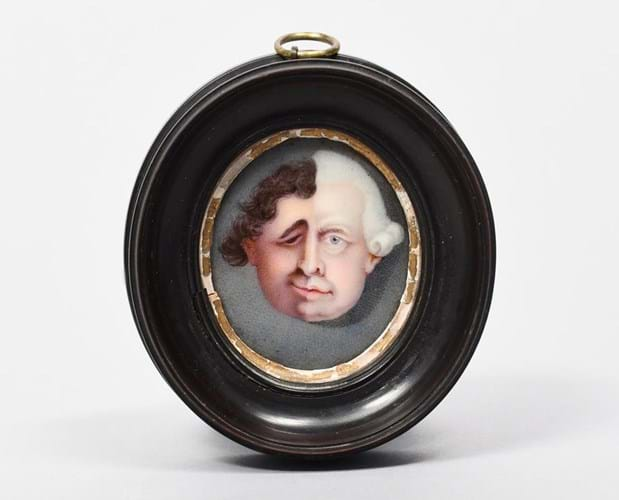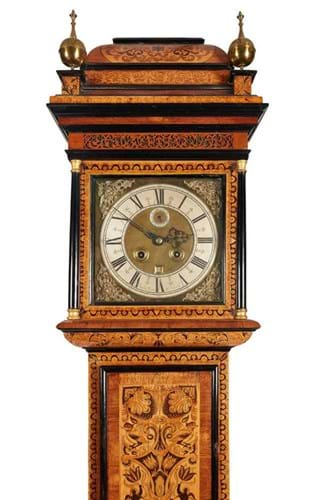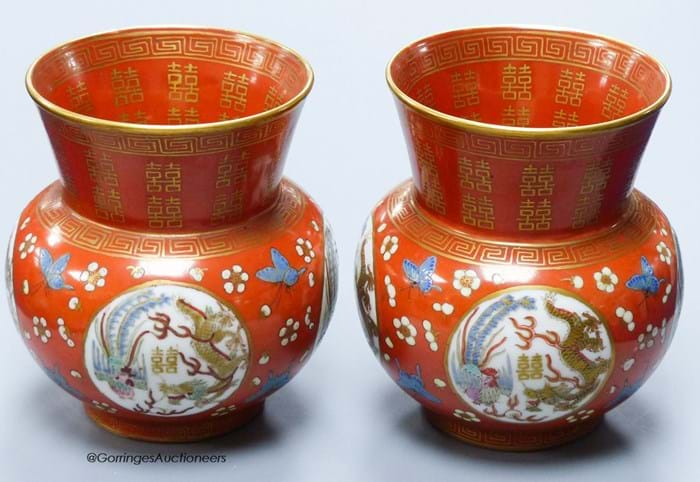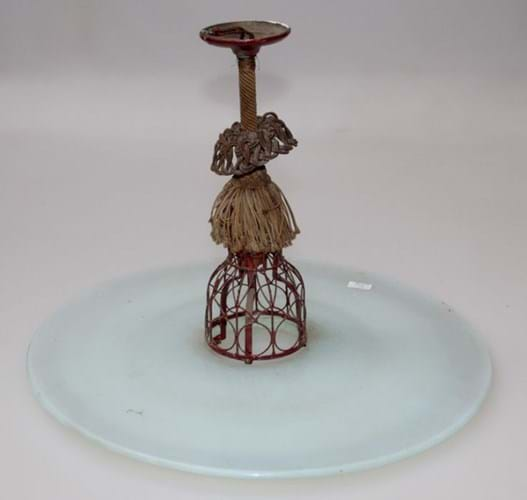1. Rare Edinburgh longcase
Edinburgh made clocks that predate 1700 are rare. Andrew Brown or Broun (c. 1651-1712) whose name appears to this clock was apprenticed to Humphrey Milne in 1665 and became a freeman of the Hammermen's Incorporation a decade later. Although recorded as a highly capable maker, he apparently died penniless, with his son applying to the Incorporation for financial assistance on his father's death. John Smith, author of Old Scottish Clockmakers from 1453 to 1850, states: "In view of the long time he was in business, 35 years, it is remarkable how exceedingly scarce are specimens of his art, only three have come under our notice: one being the splendid clock in the lobby of the Advocates Library, another that was exposed for sale in the window of a dealer in Queen Street Edinburgh, both these two having cases of beautiful and chaste marquetry; and the third one in possession of a private party in Linlithgow".
It was the second of those three clocks that was offered for sale at Lyon & Turnbull in Edinburgh on September 1 as part of the firm’s Five Centuries sale.
In addition to its ebony, rosewood and marquetry cases it has a month-going five pillar movement with five trains, anchor escapement and outside count-wheel hour strike. Estimated at £8000-12,000, it found a buyer at £36,000.
2. Lord North and Charles James Fox coalition plaque – £3000

Lord North and Charles James Fox coalition enamel plaque, c.1783 – £3000 at Woolley & Wallis in association with Historical & Collectable.
Among the many highlights of the Robin Simpson (1940-2020) collection of British commemorative ceramics was this curious enamel portrait plaque.
Painted with combined portraits of the faces of Lord North and Charles James Fox, it is titled to the reverse Lord Nth & Chles Jms Fox Coalesed. It dates from c.1783, the year the two great political adversaries formed a coalition government.
With the overwhelming support of North’s Tories and Fox’s opposition Whigs, the pair came to power on April 2, 1783. The coalition lasted until March 1784 and collapsed after the failure of Fox's East India Bill. Estimated at £800-1200, it took £3000.
It was part of the Robin Simpson (1940-2020) collection of British commemorative ceramics that came for sale at Woolley & Wallis’ Salisbury salerooms earlier this month.
Well-known for an encyclopaedic knowledge of British history, Simpson, who worked for the Department of Trade and Industry, was considered the leading collector in this field. Focusing on wares from the pre-Victorian periods, over 30 years he amassed a collection of over 550 pieces chronicling royal, social, political, war and maritime events from the reign of William and Mary to the 1838 coronation.
Simpson had hoped that the collection might remain intact in an institution but, after enquires led nowhere, he entered into discussions with Andrew Hilton of Historical & Collectable, known for the regular specialist auctions of commemoratives, to handle the sale of the collection.
Hilton conducted the landmark auction in conjunction with Woolley & Wallis of Salisbury on September 8.
3. Chinese vases – £39,000
Estimated at £100-150, this pair of 4in (11cm) Chinese vases sold for an estimate-busting £39,000 at Gorringe’s in Lewes on September 6. Gold decoration on a coral-red ground was revived during the Kangxi period and reached its height in the Qianlong and Jiaqing periods.
However, many pieces of this type are thought to be made in the Republic era. This particular pair of vases, probably early 20th century, would make a perfect wedding gift. They are decorated in famille rose enamels with four ‘dragon and phoenix’ roundels (symbolic of the emperor and the empress and blissful relations between husband and wife) and butterflies and prunus blossom (a quest for blissful love). In gold across the whole surface are shuang xi (double happiness) characters while to the base is a red four character mark that reads ‘celebrate together eternal youthfulness’.
4. Edwin Lutyens light fitting – £5800
Sir Edwin Lutyens designed a number of daring light fittings for his architectural projects – all of them rare and desirable objects. It was given only a rudimentary catalogue entry and an estimate of just £30-50 but one emerged for sale at Hansons saleroom in Banbury on September 4. The hammer price was £5800.
This ceiling light made in vaseline and frosted glass with a red painted aluminium and steel cage and passementerie hanging is a variant of the 'Cardinal's Hat’, fittings originally designed for Campion Hall, the Jesuit College of Oxford University built in 1935-42.
The design was also privately used by Lutyens in the homes of his children and was reproduced recently as part of the restoration of The Ned Hotel in London, formerly the headquarters of the Midland Bank. Similar examples are pictured in Sir Edwin Lutyens, Designing in the English Tradition (Elizabeth Wilhide, 2000).
Hansons’ example (incorrectly assembled in the illustration) is unusual as it has a bell-shaped rather than a hemispherical cage. Another of this type, sold for £30,000 at a Phillips sale in September 2017, was previously owned by one of Lutyens’s grandchildren. The Oxfordshire example came for sale from a flat in London – a property with no apparent connection with Lutyens.
Another Lutyens light fitting emerged for sale at Hartley’s in Ilkley in 2016. This ‘halo’ design pendant fitting came from Gledstone Hall, Skipton, North Yorkshire. Lotted with a modest estimate of £150-£200, it romped away to an online buyer for £5000.
5. Cryséde crepe-de-chine piano shawl – £2100
Alec Walker (1889-1964) created Cryséde fabrics as a small experimental silk printing firm in Newlyn in 1920. Living in Myrtle Cottage and working from a row of three derelict fishermen’s cottages in Sambo’s Row, his artist wife Kay Earle (1893-1966) designed dresses and patterns and he created colourful designs that were dyed and printed by local girls.
At its peak in the years 1923-33, when only Walker’s designs were used, the firm had a healthy list of international mail order clients and a run of local shops. Today Cryséde fabrics are recognised as important products of the Newlyn art scene in the inter-war period. H
owever, seldom do they command the reaction afforded this crepe-de-chine piano shawl decorated with a vibrant stylised landscape design offered by David Lay in Penzance on September 2. Estimated at £80-120, it was sold to a buyer using thesaleroom.com at £2100.









